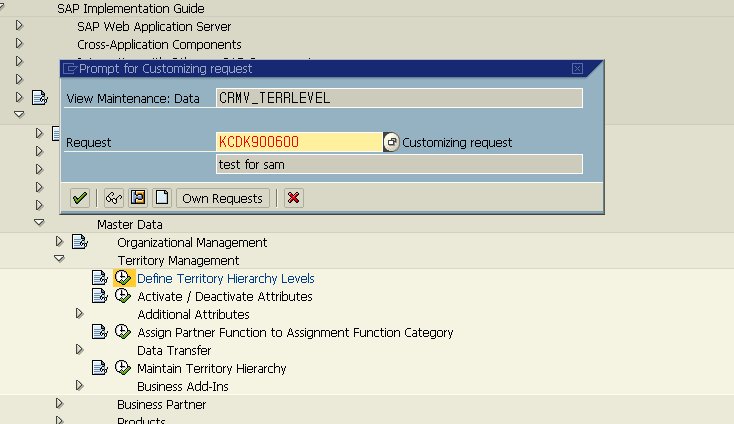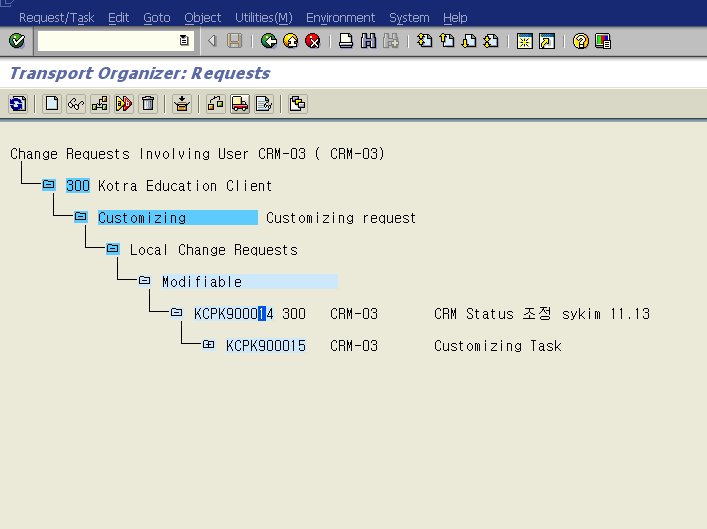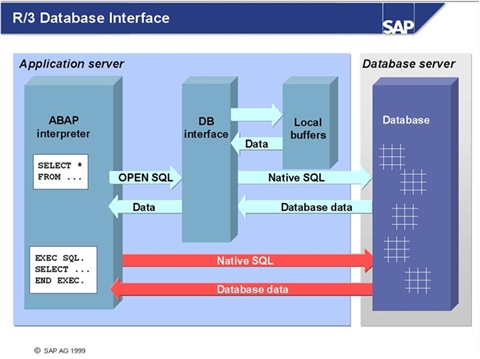
'ERP/SAP/R/3'에 해당되는 글 51건
- 2011.04.20 OPEN SQL 성능비교 - T-CODE: SE30
- 2011.04.20 ABAP Dictionary & Database Table
- 2011.04.19 What is the difference between Type and Like?
- 2011.04.19 ABAP Dictionary의 Type
- 2011.04.19 CTS(Change andTransport System) - 프로그램 버전관리
- 2011.04.19 CTS(Change andTransport System)
- 2011.04.15 MRP(Material requirements Planning) 간단하게 정리
- 2011.04.13 Open & Native SQL
- 2011.04.11 SAP 업무별 사용 테이블
- 2011.04.08 자재소요계획 - MRP(Material Requirements Planning)
=> 100 번 클라이언트에서 생성된 테이블은 200,300번 클라이언트에 반영되지만,
100 번 클라이언트에서 생성된 데이타는 100번 클라이언트에만 존재한다
예) MANDT 값을 WHERE 조건에 넣지 않고 조회시 6건의 데이터가 조회된다.(NATIVE SQL사용) - 아래 캡쳐 참조
ABAP Dictionary(프로그램, 테이블 등) : Client-dependent
= > 각 클라이언트에 포함된 DATA만 반영한다.
예) 클라이언트 100에서 데이터를 조회하면 2건의 데이타가 조회된다.(OEPN SQL사용시) - 아래 캡쳐 참조
CF> 다른 client의 data를 조회하고 싶다면
SELECT * FROM SPFLI CLIENT SPECIFIED
WHERE MANDT = '100'
ENDSELECT.
----------------------------------------------------------------------------------------------------------------
실제 물리적인 테이블은 MANDT 필드에 클라이언트 정보를 포함하여 데이터가 저장된다.
OPEN SQL을 사용하게 되면 자동으로 해당 클라이언트의 정보가 포함
NATIVE SQL을 사용할 경우에는 WHERE 조건에는 반드지 MANDT가 포함되야 한다.

출처 : EASY ABAP 책
1. TYPES : 선언 만되고 개체가 생성은 되지 않음
TYPES : BEGIN OF line,
col1(10) TYPE c,
col2(10) TYPE c,
END OF line.
DATA itab TYPE TABLE OF line WITH HEADER LINE. "OK
*DATA itab LIKE TABLE OF line WITH HEADER LINE. " ERROR
=> LIKE의 data(개체)로 선언되어 진 것만 사용 가능하다.
다음과 같이 작성해야 한다.
types : BEGIN OF str,
col1(10) TYPE c,
col2(10) TYPE c,
END OF str.
data: line type str. " DATA 개체가 생성
DATA: itab LIKE table of line WITH HEADER LINE. " 생성된 개체를 참조*DATA: itab type TABLE OF line WITH HEADER LINE.
2. DATA : 선언과 동시에 객체도 생성됨
data : BEGIN OF line,
col1(10) TYPE c,
col2(10) TYPE c,
END OF line.
DATA: itab LIKE table of line WITH HEADER LINE. "OK
DATA itab type TABLE OF line WITH HEADER LINE. "OK
----------------------------------------------------------------------------------------------------------------------
==실행 TEST SOURCE==
*itab-col1 = 'a'.
line-col1 = 'kim'. line-col2 = 'eunjeong'.
append line to itab.
*INSERT table itab.
line-col1 = 'park'. line-col2 = 'youngha'.
append line to itab.
*INSERT table itab.
LOOP AT itab into line.
WRITE :/ line-col1, line-col2.
ENDLOOP.
ABAP Dictionary(Table, Structure,Data Element)는 Global Data type이다.
그러므로 모든 프로그램에서 Data Type으로 선언하여 사용할 수 있다.

1. Database Tables and views : ... TYPE dbtab, .. TYPE dbtab-comp
2. Data Types : Data Elements, Structures, Table types
3. Type Groups

다음과 같이 예전 버전으로 복구가 가능하다.

ERP란 이미 개발되어진 프로그램을 각 회사에 맞게 Customizing하는 형태로 Project이 진행된다.
따라서 개발 시스템에서 각 회사의 특성에 맞게 Parameter값을 설정한 후 기능 테스트를 한다.
테스트 후 문제가 없을 경우 개발시스템에 설정한 Parameter값을 다시 영시스템에 설정하는 것이 아니라 개발시스템의 값을 운영에 넘겨야 한다.
이때 이러한 기능을 담당하는 것이 CTS(Change request Transport management System)이다.
SAP시스템에서 각 Parameter를 설정을 할 경우 아래와 같이 Change request 번호가 부여된다.


다음 "STMS" 화면에서 운영시스템으로 직접 전송을 하면 각 Parameter값이 반영이 된다.



When interpreting open SQL statements, the R/3 database interface checks the syntax of these statements and automatically ensures the local SAP buffers in the shared memory of the application server are utilized optimally. Data frequently required by the applications is stored in these buffers so that the system does not have to access the database server to read this data. In particular, all technical data such as ABAP programs, screens, and ABAP Dictionary information, as well as some business process parameters usually remain unchanged in a running system, making them ideal buffering candidates. The same applies to certain business application data, which is accessed as read-only.
** 각 업무별 사용 Table 내역
1. 자재마스타 관리 Table
- MARA Material Master: General Data
- MARC Material Master: 자재에 대한 플랜트데이타
- MARD Material Master: Storage Location/Batch Segment
- MAKT Material Descriptions
- MBEW Material Valuation
- MVKE Material Master: Sales Data
- MARC_WERK
- T132 Status definition
- MBEWH 기초재고관리 TABLE
- MARM 자재별 단위 conversion rule
2. BOM 관리 Table
- MAST : Material to BOM Link
- STKO : BOM Header
- STPO : BOM Item
- STPU : BOM Sub-Item
- STAS : BOMs - Item Selection
3. INFO Record 관리 Table
- A018 Material Info Record
- EINA Purchasing Info Record - General Data
- EINE Purchasing Info Record - Purchasing Organization Data
- KONH Conditions (Header)
- KONP Conditions (Item)
4. Quota Arrangement 관리 Table
- EQUK Quota File - Header
- EQUP Quota File - Item
5. Source List 관리 Table
- EORD Purchasing Source List
6. Vendor Master 관리 Table
- LFA1 Vendor master (general section)
- LFB1 Vendor master (company code)
- LFBK Vendor master (bank details)
- LFM1 Vendor master record purchasing organization data
7. Inspection Plan 관리 Table
- MAPL Allocation of task lists to materials
- PLKO Task list - header
- PLMK Inspection characteristic
- PLMW MAPL-dependent characteristic values (inspection plan)
- PLPO Task list - operation/activity
8. Customer Master 관리 Table
- KNA1 General Data in Customer Master
9. Quality Management 관리 Table
- MAPL Allocation of task lists to materials
- QDQL Quality level
- QALS Inspection lot record
- QAMR Characteristic results during inspection processing
- QAMV Characteristic specifications for inspection processing
- QAVE Inspection processing: Usage decision
- QMAT Inspection type - material parameters
10. Kanban Master 관리 Table
- PKHD Control cycle header
11. Purchase Requisition 관리 Table
- EBAN Purchase Requisition
- EINA Purchasing Info Record - General Data
- EINE Purchasing Info Record - Purchasing Organization Data
- LFM1 Vendor master record purchasing organization data
- T001K Valuation area
- T001W Plants/Locations
- T024E Purchasing Organizations
- T160 SAP Transaction Control, Purchasing
- T161A Linkage of Requisition Doc. Type to Purchasing Document Type
- T161W Order Types for Stock Transfer
12. Purchase Document 관리 Table
- EKKO Purchasing Document(RFQ,CONTRACT,PO) Header
- EKPO Purchasing Document(RFQ,CONTRACT,PO) Item
- EKET Delivery Schedules
- EKBE History of Purchasing Document
- EKKN 계정지정 구매문서 관련 테이블
13. Sales Order 관리 Table
- KNA1 General Data in Customer Master
- VBAK Sales Document: Header Data
- VBAP Sales Document: Item Data
- VBEP Sales Document: Schedule Line Data
14. SOP (Sales & Operation Planning) 관리 Table
- S076 Sales & Operations Planning
- S076E S076 - Structural Information
- SAUF SOP Orders
- P445G Parameters for PLOB Version_Key Figure
- P445X LIS Planning Versions Table
- P44V Planning Versions
15. Demand Management 관리 Table
- PBIM Independent requirements for material
- PBED Independent requirements data
- PBHI Independent requirements history
16. Work Center 관리 Table
- CRHD Work Center Header
- CRCO Assignment of Work Center to Cost Center
- KAKO Capacity Header Segment
- TC31A Key for performance efficiency rate
17. Cost Center 관리 Table
- CSKS Cost center master
- CRCO Assignment of Work Center to Cost Center
18. Routings 관리 Table
- MAPL Allocation of task lists to materials
- PLAS Task list - selection of operations/activities
- PLKO Task list - header
- PLPO Task list - operation/activity
19. Complete Confirmation 관리 Table
- AFRU Order completion confirmations
20. Planned Order 관리 Table
- PLAF Planned order
- MKAL Production Versions of Material
21. Production Order 관리 Table
- AFKO Order header data PP orders
- AUFK Order master data
- AFPO Order item
- AFVV DB structure of the quantities/dates/values in the operation
- AFVC Operation within an order
- AFRU 확정번호를 키로 해서 액티비티 값을 가지고 있는 테이블
22. CRP (Capacity Requirement Planning) 관리 Table
- KAKO Capacity Header Segment
- KBKO Header record for capacity requirements
- KBED Capacity requirements records
23. Reservation 관리 Table
- RKPF 예약문서:헤더
- RESB Reservation/dependent requirements
- JEST Object status
24. 구매조직 관리 Table
- T024 Purchasing Groups
- T024D MRP
25. Storage Loc. 관리 Table
- T001L Storage Locations
26. 화폐단위 관리 Table
- TCURX Decimal places in currencies
- TCURR Currency exchange rates
27. Goods Receipt/Issue 관리 Table
- MKPF Header: Material Document
- MSEG Document Segment: Material
- MSLB Special Stocks with Vendor
- S031 기간(월..)별 입출고 합계수량/금액
- S032 재고이동이나 송장검증 또는 자재금액변경 등의 transaction이 발생할 때
이 정보구조에 반영.기간이 없다.
- S033 일 기준으로 재고이동이나 송장검증, 자재금액변경 등의 transaction이 발생할 때
이 정보구조에 반영. transaction 개개별로 update가 된다.
28. Message관리 Table
- T100 Messages
29. Plant 관리 Table
- T001 Company Codes
- T001W Plants/Locations
- T001L Locations정보
30. User 관리 Table
- USR01 User master record (run-time data)
- USR02 Logon data
- USR03 User address data
- USR04 User master authorizations
- USR05 User Master Parameter ID
31. SAP R/3 프로그램 관리 Table (SAP & CBO)
- DD02V Generated table for view DD02V
- TRDIR System table TRDIR
32. SAP R/3 테이블 관리 Table (SAP & CBO)
- DD02L SAP tables
- DD02T R/3-DD: SAP Table Texts
- DD02V Generated table for view DD02V
- TADIR Catalog of R/3 Repository objects
33. MRP 관련 Table
- MKPF Header: Material Document
- MDSM Simulative dependent requirements
- MDTB MRP table
- MDVM Entry in MRP File
- MDKP Header data for MRP document
34. Vendor Evaluation관련 Table
- ELBK 가중키,Overall score(업체별)
- ELBP scores for main/subcriteria(업체별)
- S013 업체평가관련 통계테이블(업체-자재별)
- T147K customizing의 채점방법관련 테이블
35. Invoice Verification관련 Table
- RBKP Header 관련
- RSEG Item 관련
- BKPF 회계전표:Header 관련
- BSEG 회계전표:Item 관련
36. Batch관련 테이블
- MCHA Batch
- MCH1 Batch (플랜트간 Batch 관리일 경우)
- MCHB Batch재고
- MCHBH Batch 재고: 이력
36. Archive관련 테이블
- ADMI_RUN Object name : MM-EBAN(for Purchase Requisitions)
MM-EKKO(for Purchasing Documents)
37. Classification관련 테이블
- ZSD001V object별 특성값
38. AUTOPOSTING관련 테이블
- T030
39. 세금관련 테이블
- BSET
- T007S 코드와 내역
40. 이동유형(Customizing) 관련 테이블
- t156 이동유형관련 Customizing 테이블
41. 업체주소관리 테이블
- ADRC 업체명,주소,전화번호 관리 테이블
벤더마스타와 구매문서의 ADRNR필드와 ADRC-ADDRNUMBER가 키로 되어 있음.
[출처] SAP 업무별 사용 테이블|작성자 뮤즈
MRP(Material Requirement Planning)는 우리 말로 '자재소요계획'이라고 불립니다.
MRP는 최종 제품(Final Product 또는 End Product)이 필요한 시점으로부터 해당 제품의 제조 또는 조립에 필요한 하위 부품들이 필요한 시점을 역으로 계산해내는 시스템 또는 방법을 가리키는 말입니다. MRP의 계산 로직에 대해서는 이후에 자세히 설명드릴 것입니다. 그에 앞서, MRP가 생산 관리 시스템 중에서 어떠한 위치에 있는지(어떠한 역할을 하는지) 살펴보도록 하겠습니다.

[그림 2.1] 생산계획 및 통제의 기본 구조
위의 그림은 생산계획 및 통제의 기본 구조를 나타낸 것입니다. 위의 그림은 어떠한 기업이 제품을 만들게 되기까지의 과정 중에서 생산 관리와 밀접한 관련을 가지고 있는 부분의 흐름을 도시화한 것입니다. 위의 그림에는 수요예측, 생산계획, 기준생산계획, 자재소요계획, 현장관리, 구매와 같은 기능 또는 업무들과 MRP의 기준 정보라고 불리우는 자재구조명세서(BOM), MPS/MRP 레코드, 자재명세서(Item Master), 재고 레코드 등이 있습니다. 각각의 기능 또는 정보에 대해서는 추가로 설명하도록 하겠습니다. 먼저, 간략하게라도 흐름을 파악하는 것이 필요하다고 생각되기에, 위의 그림을 기준으로 생산 계획의 흐름에 관한 설명을 드리도록 하겠습니다.
생산계획 및 통제의 구조를 간략하게 살펴보도록 하겠습니다.
1) 기업에서는 어떠한 제품이 기간별로 얼마만큼이나 팔릴 것인지를 예측한 자료를 활용하여 생산계획(Production Plan)을 수립하게 됩니다. 생산 계획 단계에서는 제품 단위의 계획을 수립하기도 하지만, Make-to-Stock 환경하의 기업에서는 대개 제품군 단위(Product Family 또는 Product Group)로 생산계획을 수립하는 것이 일반적입니다. 생산 계획 활동에서는 생산 용량( 기계 용량, 인력 )의 조정까지를 계획 범위에 포함시키는 것이 상례입니다.
2) 생산 계획에 기준하여 제품의 주(week)별 생산 계획량을 수립하는 활동이 기준계획수립(Master Production Scheduling)입니다. 기준 계획을 수립하기 위해서는 제품별 수요예측치와 현 재고량에 대한 데이터가 필요합니다. 기준 계획은 일반적으로 최종 제품(End Item 또는 Final Product)을 대상으로 수립되지만, 필요에 따라 중간 제품(sub-assembly 또는 component)을 계획의 대상에 포함시키기도 합니다.
3) MPS(Master Production Schedule)는 최종 제품에 대한 생산 계획(재고 계획)이기 때문에, 제품을 구성하는 부품 단위의 생산 계획(또는 재고 계획 수립)이 필요하게 됩니다. 제품을 구성하는 제품(부품)의 종류 및 그 수량에 대한 정보를 가지고 있는 BOM(Bill of Material) 데이터, 제품(부품)별 주문 방법 및 주문량에 대한 정보를 가지고 있는 Item Master Data, 각 부품 및 제품별 재고에 대한 정보를 가지고 있는 재고 데이터(Inventory Record) 를 이용하여 각 부품별 소요량을 시점별로 계산할 수 있으며, 이 결과는 MRP 레코드에 저장됩니다.
4) 이제 각 부품별로 어느 시점에 얼마만큼 필요한 지가 계산되었습니다. 기업에서는 이러한 계획치 중에서 가까운 장래의 계획을 고정(Firm Planned)시킨 후에, 제조가 필요한 부품에 대해서는 제조 명령(Production Order)를 내리고, 구매가 필요한 부품에 대해서는 구매 명령(Purchase Order)를 생성하여 처리하게 됩니다. Production Order는 현장에서 적절한 스케쥴링 등의 과정을 통하여 제품의 생산에 이용되며, 생산된 제품 또는 부품은 재고 창고에 입고되게 됩니다. 재고 창고에 입고되면, 재고 레코드의 데이터는 갱신되게 됩니다. 구매 명령은 구매 부서에 수령된 후에 적절한 구매 절차를 통하여 구매로 이어집니다. 구매가 이루어진 부품들은 재고 창고에 입고된 후에 재고 레코드에 반영되게 됩니다.
출처 : http://ultra.snu.ac.kr/erp/ver3/erp/erp_2_1.html


